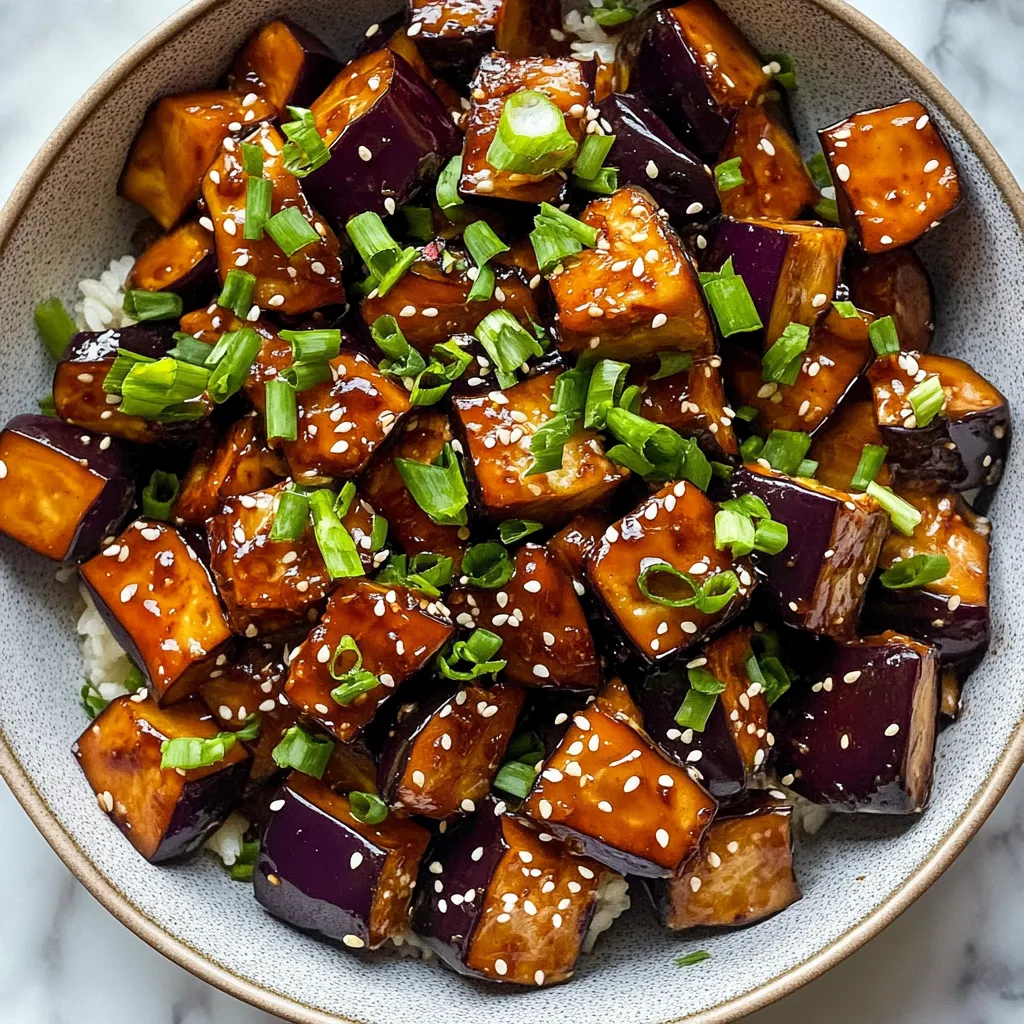 Pin it
Pin it
This gochujang eggplant transforms humble vegetables into a spicy Korean-inspired masterpiece that will have you rethinking how exciting plant-based meals can be. The tender, silky eggplant soaks up the bold gochujang sauce, creating an irresistible combination that's become my weeknight dinner savior when I'm craving something with serious flavor but minimal effort.
This recipe saved me countless times when unexpected guests arrived. The first time I made it, I was skeptical about combining eggplant with gochujang, but the marriage of silky texture and spicy sauce converted even my most eggplant-resistant friends into devotees.
Ingredients
- Medium eggplants: The perfect vehicle for soaking up the flavorful sauce. Look for firm eggplants with glossy skin and no soft spots
- Gochujang: Korean red chili paste that provides the signature spicy flavor with subtle sweetness. Find it in Asian grocery stores or international aisles
- Soy sauce: Adds essential umami depth and saltiness. Use low sodium if watching salt intake
- Rice vinegar: Brings necessary acidity to balance the rich sauce. Choose unseasoned for more control
- Honey or maple syrup: Counterbalances the heat with natural sweetness. Maple syrup makes the dish vegan
- Sesame oil: Provides nutty aromatic flavor. A little goes a long way
- Fresh garlic and ginger: Creates the aromatic foundation. Always use fresh for the best flavor
- Vegetable oil: For cooking with high smoke point
- Green onions: Add brightness and color contrast. Choose bunches with firm, vibrant stalks
- Sesame seeds: Provide visual appeal and textural contrast. Toast them first for enhanced flavor
Step-by-Step Instructions
- Prepare The Sauce:
- Combine gochujang paste, soy sauce, rice vinegar, honey or maple syrup, and sesame oil in a small bowl. Whisk until completely smooth and integrated. The sauce should have a glossy appearance and thick consistency that will cling beautifully to the eggplant. This can be done up to 3 days ahead and stored refrigerated.
- Create The Aromatic Base:
- Heat vegetable oil in a large skillet over medium high heat until shimmering but not smoking. Add minced garlic and ginger, stirring constantly to prevent burning. Cook for exactly 60 seconds until fragrant and slightly softened. The aromatics should become golden but not brown, as browning will create bitterness.
- Cook The Eggplant:
- Add cubed eggplant to the skillet with a pinch of salt. The salt helps draw out moisture and prevents the eggplant from absorbing too much oil. Cook for 8 to 10 minutes, stirring occasionally to promote even browning. Be patient during this stage as properly cooked eggplant should be tender throughout with no spongy texture remaining.
- Combine With Sauce:
- Reduce heat to medium to prevent sauce from burning. Pour prepared gochujang sauce over the tender eggplant. Add most of the chopped green onions, reserving about 2 tablespoons for garnish. Gently fold everything together, ensuring each piece of eggplant is evenly coated with the vibrant sauce.
- Final Simmer:
- Allow the eggplant and sauce to cook together for 2 to 3 additional minutes. The sauce will thicken slightly and penetrate the eggplant. Stir occasionally to prevent sticking and ensure even coating. The eggplant should look glossy and richly colored when ready.
- Garnish And Serve:
- Transfer to a serving dish immediately. Sprinkle with reserved green onions and sesame seeds. The contrasting colors and textures create visual appeal while adding fresh flavor. Serve while hot for the best taste experience.
 Pin it
Pin it
You Must Know
My absolute favorite part of this recipe is the gochujang paste. I discovered it years ago during a Korean cooking class and have been obsessed ever since. The complex fermented flavor provides so much more dimension than regular hot sauce. I always keep a tub in my refrigerator now for quick flavor boosts to everyday dishes.
Serving Suggestions
This gochujang eggplant pairs beautifully with steamed rice which helps balance the spiciness while soaking up the delicious sauce. For a complete meal, I often serve it alongside a simple cucumber salad dressed with rice vinegar and a sprinkle of sea salt. The cool, crisp cucumbers provide a refreshing counterpoint to the rich eggplant. If you want to make it more substantial, add pan fried tofu cubes or a soft boiled egg on top for added protein.
 Pin it
Pin it
Making Ahead And Storage
The beauty of this dish is how well it keeps. After cooling completely, store leftovers in an airtight container in the refrigerator for up to 3 days. The flavors actually develop and improve overnight, making this perfect for meal prep. To reheat, simply microwave until hot or gently warm in a skillet with a splash of water to prevent sticking. I find the leftovers particularly delicious served cold as part of a lunch bowl with fresh greens and rice.
Adjusting The Heat Level
While gochujang brings wonderful complexity, you can easily adjust the spice level to suit your preferences. For a milder version, reduce the gochujang to 1 tablespoon and increase the honey or maple syrup slightly. Conversely, for heat lovers, add a teaspoon of Korean gochugaru red pepper flakes or a small amount of fresh minced hot pepper to the sauce. Remember that the spice level intensifies slightly as the dish sits, so leftovers may taste spicier than when freshly made.
Frequently Asked Questions
- → What is gochujang?
Gochujang is a Korean red chili paste made from fermented soybeans, red chili powder, glutinous rice, and salt. It’s known for its sweet, spicy, and umami flavors.
- → Can I substitute the eggplant?
Yes, you can use other vegetables like zucchini, mushrooms, or bell peppers, but adjust cooking times to ensure they’re tender.
- → Can I make this dish vegan?
Yes, use maple syrup instead of honey and verify the gochujang you’re using doesn’t contain any animal-derived ingredients.
- → What can I serve this with?
Serve this dish over steamed rice, quinoa, or noodles. It also pairs well with Korean side dishes like kimchi or cucumber salad.
- → How do I store leftovers?
Store leftovers in an airtight container in the refrigerator for up to 3 days. Reheat in a skillet over medium heat for best results.
